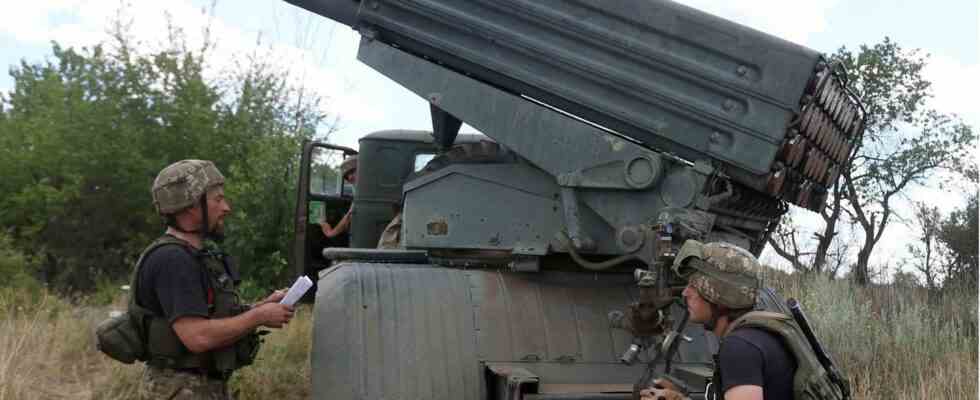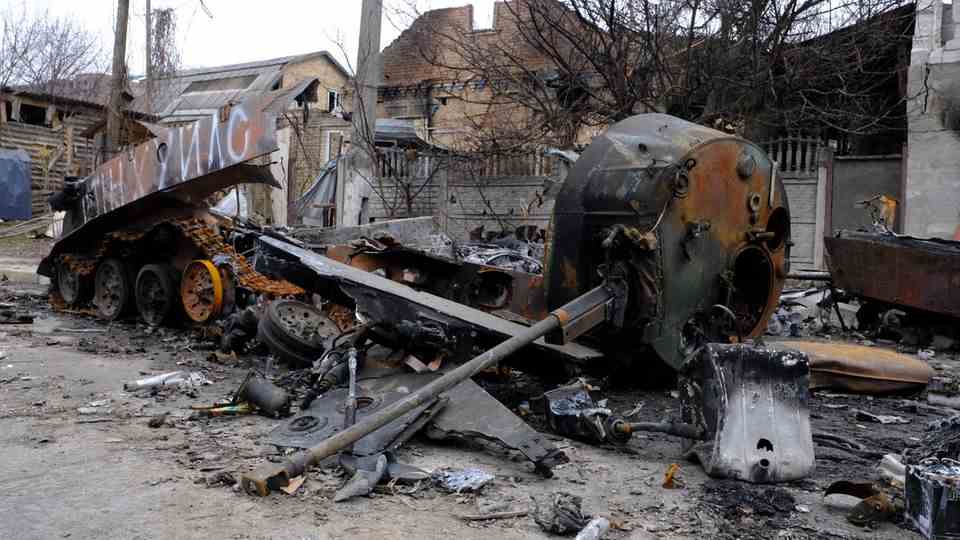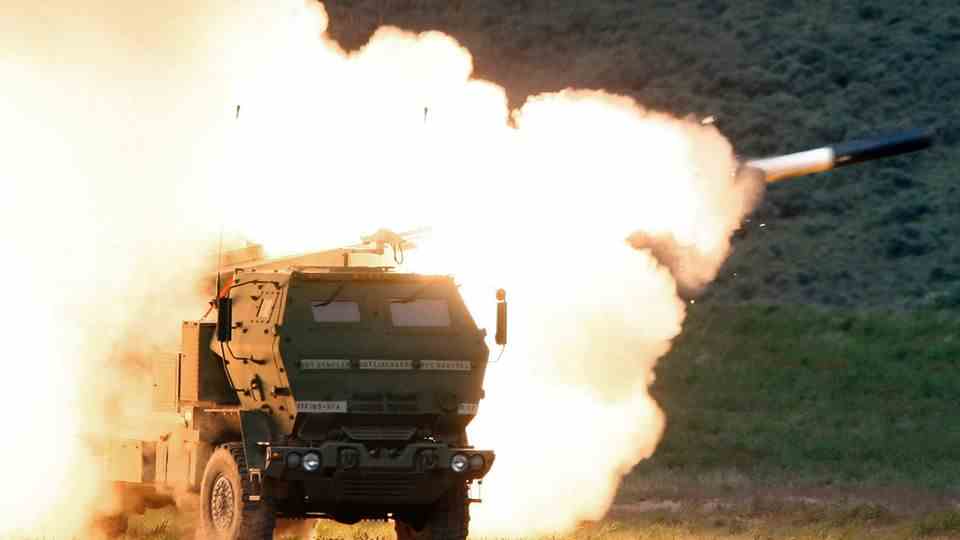Donbass and Kherson
The third phase of the Ukraine war begins – now the offensive race begins
Ukrainian soldiers firing a Type Grad BM-21 multiple rocket launcher.
© Anatolii Stepanov / AFP
Kyiv wants to liberate Kherson, Moscow wants to conquer the whole Donbass. Both sides are preparing their offensives – timing will be crucial.
The war in Ukraine is entering a third, probably decisive phase. In the first phase, in a daring operation with several deep offensive wedges, Russia tried to overthrow Ukraine in a few days. This attempt failed, at the end of the first phase the Russian troops had to retreat after heavy losses in front of Kyiv and Kharkov. A clear defeat for Putin, not forgetting that during this phase the Russians were able to conquer and hold large areas in the south and east.
Principle “fire roller”
Then the second phase began. After a redeployment of Russian forces, the Donbass offensive began. The Russians acted more cautiously, tried to avoid their own casualties and instead of making bold advances, they relied on the “barrage of fire” principle. Their superior heavy artillery wore down the Ukrainian defenders and leveled their positions. It is undisputed that Russia was able to conquer the entire Luhansk Oblast and snatch the twin cities of Severodenetk and Lysychansk from Kyiv. This is undoubtedly a success for Moscow. It is put into perspective by the very limited profits compared to the first rush.
The decisive variable in this phase are the losses of both sides in man and equipment and they are kept top secret. The hope of Kiev and thus of the West is that Putin’s troops had to buy the limited gains with such heavy losses that their armed forces are largely worn out. There is no proof of this. Especially since the reports that the Russian offensive is losing strength are repeated week after week. There are also justified doubts that Kiev’s troops survived this phase largely unscathed.
Preparation for two offensives
After the capture of Lysychansk, a period of regrouping followed, with limited advances and rehearsal attacks. Now the third phase of the war has begun, in which both sides want to become offensive. Ukraine is preparing its first major offensive. It’s about the liberation of the big city of Kherson, which was lost in the first days of the war. Currently, the Ukrainian armed forces are preparing for the operation – the shaping phase of the offensive.
To this end, Ukraine is trying to recapture positions from which an actual attack on the city can take place. At the same time, they are attacking Russian logistics to make defending Cherson more difficult. A central point in this area are the broad river courses. Here the bridges are attacked with the precision missiles of the Himars launchers. Although the explosive effect of the individual projectiles is limited, this is done with good success. The rationale behind this is that without real bridges, the Russians will find it difficult to quickly relocate their own troops and bring in the ammunition needed for their type of warfare. At the same time, the Ukraine is recapturing numerous villages and towns on the east bank of the Dnieper, thus working its way towards the city and the river. So far these are just preparations. The actual offensive was announced for August, recently September was mentioned.
Russia attacks at Bakhmut
But for a few days, fighting in Donbass has increased again. Its center has shifted to the Donetsk area. So far, the Russians have hardly been able to gain ground there. Now they are attacking the important fortified town of Soledar, working their way through the suburb of Pisky in an attempt to attack the Ukrainian forces in Bakhmut, formerly Artemivsk. Heavy fighting has taken place here in recent days, but this is also a preparatory phase for the actual attack. His aim will be to break through Kiev’s last line of defense in the east. Bakhmut is almost like a breakwater in front of the city line Slovjansk – Kramatorsk – Kostyantynivka. The cities are heavily fortified and therefore difficult to conquer.
What danger is there?
Kyiv risks another Russian success in Donbass before its own offensive begins in September. That would be the case if the Russians could break through the chain of cities or cut off individual cities with a flank attack. Such a development would be fatal in the Donbass, but would also have an impact in Cherson. Because Kiev’s calculus is based on the fact that the bulk of the Russian forces are tied up in the Donbass and Moscow will not have enough troops to be able to defend Cherson against a determined attack. Should the Russian operations in the Donbass be successful before the Ukrainian go-ahead, forces can be withdrawn from there and sent south. However, if the Russian attack is exhausted without Kyiv having to give up further cities, the offensive in the south has far better prospects.
A liberation of Kherson would in itself be a significant achievement for Ukraine. In addition, Kyiv would be able to advance further towards the sea and the Crimea from Kherson. Such a thing would bring down the entire Russian position. That’s why the vision of an offensive there is so appealing. But there are also obstacles. In the Donbass, the Russians encountered the heavy fortifications built by the Ukrainian army. Conversely, the Russians began to fortify the area around Cherson with bunkers and trench systems. These installations will probably be as difficult and time-consuming for the Ukrainian forces to overcome as the Russians were for the Ukrainian fortifications. Added to this is the peculiarity of the wide river courses. They are currently playing into Kyiv’s hands because they can so easily disrupt Russian supplies. But in order to liberate Kherson, these rivers must be crossed by Ukrainian forces, which the Russians will try to prevent.
The Limits of Miracle Weapons
Kyiv is dependent on deliveries of heavy weapons from the West because the country itself cannot make up for its own losses with new products. Basically, Kyiv needs everything in terms of military equipment. Starting with boots, goggles, night vision goggles and first-aid kits. However, weapon systems with which Kyiv can achieve spectacular successes are attracting the greatest attention. That would currently be the Himars multiple rocket launchers from the USA. With them, Ukraine can attack and destroy headquarters and ammunition dumps far behind the front lines. In zones that are otherwise inaccessible. In addition to the sheer range of the missiles, there is their tremendous accuracy. This operation hinders the Russians enormously. They were already used to acting completely undisturbed in the hinterland. It is a mystery on what scale the Russians succeed in knocking out these launchers. Now you can use the formula “Quality beats quantity” to help yourself. But one thing is forgotten: the Russian armed forces rely on the mass of their fire barrage and fire vast amounts of inaccurate ammunition. But they also have precision weapons in use. Almost 3,000 cruise missiles have been fired at Ukraine so far. And even if the Russians have to improvise now, such as using surface-to-air missiles against ground targets, they can still show videos of numerous attacks every day, in which guided missiles hit their targets exactly. With the ability to attack camps in the hinterland, Kyiv does not have a unique selling point. Here the Ukrainian armed forces can at least partially compensate for the hitherto oppressive superiority of the Russians in the field of long-range weapons. That helps, but is certainly not enough to bring about a complete turnaround.




